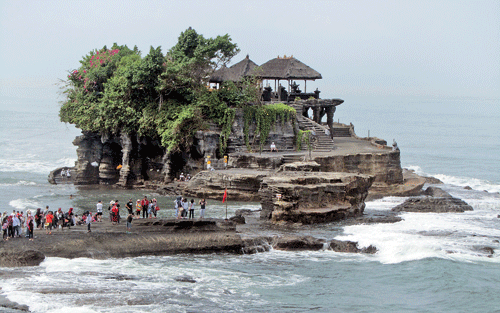Bali is heaven on earth, say the Balinese

Pura Tanah Lot: One of the most visited sites in Bali with its picturesque setting
Looking out over the ocean from the viewing platform on which I am standing the far off sight of the Gunung Ahung volcano is just about visible through the early morning clouds.
The craggy rocks below me have over the years been eroded and pockmarked by the crashing waves of the Indian Ocean. They now resemble something out of a moonscape. At this early hour the water is calm and a few feet away from me a couple of tourists are busy taking selfies with the ocean in the background.
I am in Bali – the tiny island in the middle of the Indonesian archipelago just eight degrees south of the equator and known by its inhabitants as “the island of the gods”. For generations its unique culture and way of life have been attracting people –some like me who come for short visits and others who come to stay.
Indonesia itself is a nation made up of over 18,000 islands – home to 200 million people, most of them Muslims. Bali, just 2500 square metres in size and separated by the three mile wide Bali Strait from the large island of Java, is home to four million people of whom over 90% are Hindus.
But to say that the Balinese are Hindus does not convey the whole story. Theirs is a unique form of Hinduism which evolved from the original animist religions existing in these islands. During my stay here I was fortunate to visit several of these “Balinese Hindu” temples such as Pura Batu Bolong, Pura Tanah Lot, Pura Taman Ayun and Pura Ulun Datu.
The Balinese temple (known as Pura) has no statues of various deities as one would see in a Hindu temple in Sri Lanka or India – and no resident clergy (as one would certainly meet in Buddhist and Hindu temples in our country). Significantly, entering the interior of these temples is limited to those members of the particular religious community who “belong” to that temple – outsiders are not permitted inside.
We visited Pura Tanah Lot with its crashing waves and beautiful sunsets – one of the most visited sites in Bali, being picturesquely located on a tiny island (which can be reached along a narrow causeway during low tide) and the nearby Pura Batu Bolong to which one can walk along a dramatic rocky arch. Pura Ulun Danu with its 11 storey Meru tower is located on the shores of Bratan lake while the attractive Pura Taman Ayun is situated in a beautiful garden with ponds and ornamental trees.
Like Sri Lanka Bali was conquered by the Dutch and remained a Dutch colonial possession until independence in 1949 when it became part of the Republic of Indonesia. The original Dutch invasion in 1906 is remembered for its brutality, particularly the capture of the present Balinese capital Denpasar. As the Dutch force approached the royal palace, the doors of the palace opened and a procession of people led by the ruler emerged, all dressed in sombre white. Solemnly approaching to about a hundred paces from the massed Dutch troops, the Raja stepped down from his palanquin and plunged his dagger into his breast – upon which the rest of his entourage began killing themselves. Just like the Jews in Masada, the Balinese preferred to commit mass suicide (a rite known as Puputan) rather than be conquered by the Dutch. About a thousand Balinese died that day – an event commemorated by the huge bronze statue at the site of the tragedy, known today as Taman Puputan.
While Sri Lanka is situated eight degrees north of the equator, Bali is located eight degrees south of the equator – so plants like frangipanis, hibiscus, crotons and coconut palms are found all over this island. Rice is the main crop, volcanic ash from the still active volcanoes on the island providing a fertile soil for agriculture with most farmers getting three crops a year. Even on the hillsides terraced rice-fields ensure that most arable land is cultivated.
We ourselves found the Bali we experienced to be a peaceful place, with a gentle smiling people.
It is said that if you ask a Balinese person what heaven must be like, they would reply “Just like in Bali” – a place where people are contented without the worries of this mundane life.


